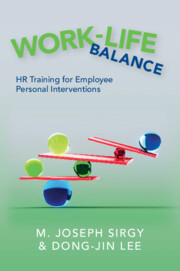Book contents
- Work-Life Balance
- Work-Life Balance
- Copyright page
- Contents
- Figures
- Tables
- Part I Making the Case for Work-Life Balance
- Part II Behavior-Based Personal Interventions of Work-Life Balance
- Part III Cognition-Based Personal Interventions of Work-Life Balance
- 9 Segmenting Roles and Domains
- 10 Integrating Roles and Domains
- 11 Engaging in Value-Based Compensation
- 12 Applying Whole-Life Perspective in Decision-Making
- Part IV Epilogue
- Index
- References
9 - Segmenting Roles and Domains
from Part III - Cognition-Based Personal Interventions of Work-Life Balance
Published online by Cambridge University Press: 19 January 2023
- Work-Life Balance
- Work-Life Balance
- Copyright page
- Contents
- Figures
- Tables
- Part I Making the Case for Work-Life Balance
- Part II Behavior-Based Personal Interventions of Work-Life Balance
- Part III Cognition-Based Personal Interventions of Work-Life Balance
- 9 Segmenting Roles and Domains
- 10 Integrating Roles and Domains
- 11 Engaging in Value-Based Compensation
- 12 Applying Whole-Life Perspective in Decision-Making
- Part IV Epilogue
- Index
- References
Summary
In this chapter we describe segmentation— a cognition-based intervention of work-life balance. Segmentation involves creating boundaries (or psychological walls) to insulate life domains. The goal is to prevent negative spillover from the segmented domain to other domains. We discuss four different segmentation interventions that people commonly use to prevent negative spillover: temporal, physical, behavior, and communicative. We also discuss intervention programs that organizations can institutionalize to achieve higher levels of employee work-life balance based on these segmentation interventions.
Keywords
- Type
- Chapter
- Information
- Work-Life BalanceHR Training for Employee Personal Interventions, pp. 103 - 114Publisher: Cambridge University PressPrint publication year: 2023

